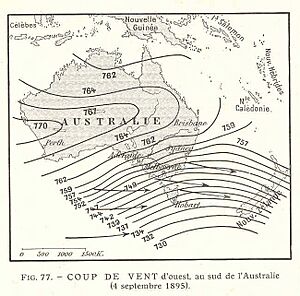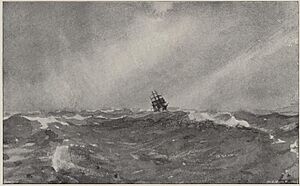Roaring Forties facts for kids
The Roaring Forties are very strong winds. They blow from the west in the Southern Hemisphere. You can find them mostly between 40 and 50 degrees south of the Equator.
These powerful winds blow from west to east. They happen because air moves from the Equator towards the South Pole. The Earth's spin also helps create them. Plus, there isn't much land in these areas to block the wind.
For a long time, the Roaring Forties helped ships. During the Age of Sail, ships used these winds to travel faster. They sailed from Europe to places like the East Indies or Australasia. Even today, sailors racing around the world love these winds.
The exact location of the Roaring Forties changes. They move north or south depending on the season. Because they are so strong and steady, these winds are great for making wind power. Places like New Zealand and Tasmania use them for this.
Even stronger winds exist further south. They are called the Furious Fifties (between 50°S and 60°S). Below 60°S, you find the Shrieking or Screaming Sixties.
Contents
How These Winds Work
Warm air rises at the Equator. Then, cooler air moves towards the Equator. This pushes the warm air towards the poles. This movement is part of Earth's air circulation.
Around 30 degrees south, the air starts to sink. It then moves closer to the ground towards the poles. This air rises again around 60 degrees south. This is where it joins the Polar vortex.
As air travels between 30 and 60 degrees south, the Earth spins. This spin makes the air currents move from west to east. This creates the strong westerly winds we call the Roaring Forties.
The Northern Hemisphere has huge landmasses. These include North America, Europe, and Asia. They block air currents a lot. But south of 40°S, there is mostly open ocean. Only Tasmania, New Zealand, and the southern part of South America are there. These small land areas don't block the wind much. This allows the winds to become very fast.
The Roaring Forties and similar winds shift their positions. They move closer to the South Pole in the southern summer. In the southern winter, they move closer to the Equator. Wellington, the capital of New Zealand, is famous for being windy. It is one of the few cities located in these gusty latitudes.
Sailing with the Winds
During the Age of Sail, ships used these winds a lot. Ships going from Europe to the East Indies or Australasia would sail south. They would go around the Cape of Good Hope. Then, they used the Roaring Forties to cross the Indian Ocean quickly.
On their way back to Europe, they kept sailing east. They crossed the Pacific Ocean and went south of Cape Horn. Then, they sailed north along the east coast of the Americas.
A Dutch explorer named Hendrik Brouwer first used this route in 1611. It was called the Brouwer Route. It cut the travel time from Europe to Java in half! Sailors used the phrase "to run the easting down" for these fast trips.
Today, sailors racing around the world still use the Roaring Forties. They help them set new speed records. An old sailor's saying about these waters goes: "below 40 degrees south, there is no law; below 50 degrees, there is no God." This shows how wild and powerful these winds can be.
How Pollution Affects the Winds
In the late 1900s, the strongest part of these winds moved south. It shifted about 2.5 degrees closer to the South Pole. This change is due to human activities. Things like ozone depletion and greenhouse gas emissions are the cause.
This shift has made Antarctica warm faster. It has also led to less rainfall in Australia, especially in Western Australia.
Roaring Forties in Pop Culture
In 1982, a French filmmaker named Christian de Chalonge made a movie. It was called The Roaring Forties. This drama was inspired by the story of Donald Crowhurst. He was a British sailor who died during a race in 1969.
See also
 In Spanish: Rugientes Cuarentas para niños
In Spanish: Rugientes Cuarentas para niños





